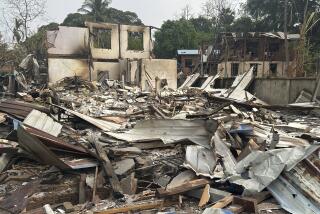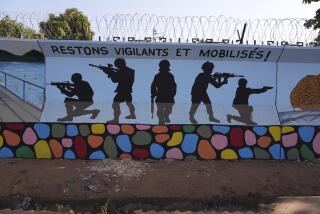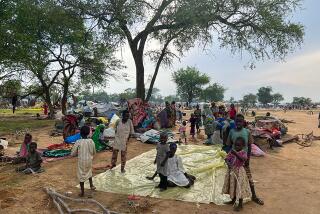Borneo Mobs Target Settlers as Bloody Slaughter Spreads
- Share via
SAMUDA, Indonesia — Gangs of headhunters armed with spears, machetes and blowguns swarmed through the lower reaches of Borneo island Sunday, hunting down and killing immigrant settlers from the island of Madura to the south.
Headless corpses littered roadsides, and bodies floated down the muddy Mentaya River as the indigenous Dayaks’ week-old campaign of “ethnic cleansing” continued to spread. Some officials said the death toll may have surpassed 1,000, with nearly all the victims Madurese.
Police appeared powerless to rein in the fierce Dayaks--descendants of the legendary headhunters of Borneo--who resent decades of government-sponsored relocation of immigrants from other parts of Indonesia.
Late Sunday, hundreds of young spear-wielding Dayaks moved into Palangkaraya, the capital of Central Kalimantan province, and set up checkpoints on the major roads, in effect seizing control of the city. As smoke billowed from burning houses around the capital, the police were nowhere to be seen.
Last week, Dayaks paraded through the town of Sampit with the heads of some of their Madurese victims on poles.
“We want all of the Madurese to leave Kalimantan and go back to where they came from because we don’t like their character,” said Dayak leader Ilus Eptinggi. “They don’t respect us.”
Headhunting was officially banned in Borneo long ago, but in reality, the practice has quietly continued. Dayaks believe that taking a head gives its new owner enhanced powers.
The outbreak of primitive violence is yet another test for the democratically oriented government of Indonesian President Abdurrahman Wahid, who already faces bloody separatist conflicts in the provinces of Aceh and Irian Jaya and religious warfare in the Molucca islands.
Many question whether the eccentric Muslim cleric can hold together this diverse and, in the case of some islands, densely populated archipelago without the strong hand of the military, which ruled Indonesia for 32 years until dictator Suharto stepped down in 1998.
During the Suharto era, ethnic conflict in Indonesia was greatly exacerbated by the policy of encouraging people to move from crowded islands like Madura to open territory like Kalimantan, the Indonesian part of Borneo.
The Dayaks, a nomadic people, were pushed to the sidelines as Madurese settlers took control of much of the province’s commerce. The Dayaks’ resentment has been building for years, and mass outbreaks of deadly anti-Madurese violence occurred in 1997 and again in 1999.
Officials said the latest round of fighting began Feb. 18 after a pair of Dayak government employees lost their jobs to Madurese workers during a government reorganization. The two provoked an attack that killed five Madurese. The Madurese retaliated, killing several Dayaks.
The violence quickly spread across Central Kalimantan in what now looks like a well-coordinated “ethnic cleansing” operation.
Tens of thousands of Madurese refugees have fled, and hundreds, if not thousands, of homes have been torched.
As with the other violent conflicts in Indonesia, Wahid has been slow to act. In his government’s first high-level response to the Borneo crisis, Security Minister Gen. Susilo Bambang Yudhoyono flew to the region Sunday and declared that the police and army were doing all they could.
“They are doing their best to stop the violence,” Yudhoyono told reporters in Sampit. “We will control the situation and enforce the law.”
In fact, police controlled only a few blocks of Sampit, which had a population of about 100,000 before the conflict began. Not far from where Yudhoyono appeared, a corpse lay in the street, rotting under the tropical sun. It had been there for at least two days.
As Yudhoyono spoke, many hundreds of armed Dayaks patrolled roads across Central Kalimantan searching for Madurese who had fled from their homes and into the jungle.
On the highways and back roads, a steady stream of vehicles carried Dayaks to the hunt. Groups of 30 or more rode in the backs of dump trucks or in large flatbed trucks. Smaller bunches packed vans hastily marked “Patroli Dayak” in red paint. Still others rode in pairs on motorcycles, with the passenger holding a spear or a long machete-like knife called a mandau.
A few of the headhunters wore white or black war paint on their faces.
The Dayaks also set up checkpoints every few miles along the roads and stationed groups of men with spears, mandaus or blowguns. One of the warriors, who declined to give his name, said he was there to catch and kill Madurese refugees coming out of the jungle.
Along the road between the towns of Sampit and Samuda, half a dozen corpses were clearly visible Sunday afternoon. Three of the victims appeared to have been killed only hours earlier. All of the bodies had been decapitated, and one, a man’s, had its hands tied behind its back.
Witnesses said the heart of at least one body had been cut out. Some Dayaks say they like to eat human hearts.
The Dayaks have been collecting the severed heads of their foes in large white bags. The same kind of bags, apparently soaked with blood, could be seen on the front bumper of a truck heading back toward Sampit with a group of warriors.
In Sampit, where the conflict was initially centered, nearly 6,000 refugees were evacuated Sunday on rescue vessels bound for Madura. At least 10,000 more remained at a crowded refugee center in town.
As the refugees boarded, bodies floated down the river, drifting past the pier or snagging on debris beneath the dock.
In towns and villages throughout the region, the Dayaks set houses on fire throughout the day and into the night.
Non-Madurese people, such as the Banjars, another indigenous group, painted their ethnic identities on the outside of their houses in the hope that they would not be torched.
In Samuda, originally a town of 32,000 people, the handful of police stationed there hunkered down on a three-block strip of the main road, the only part of the town they appeared to hold. All of the town’s 19,000 Madurese residents were gone. Some had reached safety, but at least 10,000 were hiding in the jungle, said Police Chief Jarwo, who like many Indonesians goes by only one name.
A few blocks from the police station, Dayaks set fire to the homes of Madurese settlers they had driven out.
“It’s out of control,” the police chief said.
Ismail Hadin, 71, took shelter in Samuda’s small town hall with 300 other terrified refugees after his home was burned down. A Madurese, he said he was born in Borneo but expected to see Madura for the first time.
“If God wants me to go to Madura, I will go,” he said.
More to Read
Sign up for Essential California
The most important California stories and recommendations in your inbox every morning.
You may occasionally receive promotional content from the Los Angeles Times.










